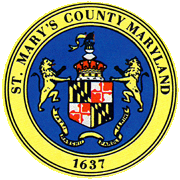St. Mary's County, Maryland
Contents
History
Leonard Calvert and a group of adventurers left Cowes, Isle of Wight in England on November 22, 1633 in two ships, the Ark (a large ship of 400 tons) and the Dove (weighing 40 tons.) A replica of the Dove is at Historic St. Mary's City. On March 25, 1634, they landed at St. Clements Island and religious ceremonies were held to give thanks for a safe voyage to the new land. On March 27th they arrived at the Indian Village of Yeocomico, and purchased it from the Indians for blankets, cloth, knives, trinkets, axes, hoes and other tools. They renamed the village St. Mary's.
By 1642, the town had at least ten houses, a forge, mill and Catholic Chapel. The colonists built homes made of wooden slabs, with roofs made of shingles. In 1664, the Assembly at St. Mary's City passed a law that could be called the first Maryland building code. The law ordered that all houses built in the town should be at least twenty feet square, two and a half stories high and built with chimneys made of brick. Originally, the chimneys had been made of logs. lined with clay. As they aged, they became fire hazards.
In 1676, the famous State House was built. It was torn down in 1829, and the bricks used to build Trinity Church. To celebrate the 300th birthday of Maryland, a replica of the State House was built.
The priceless heritage of St. Mary's City was Religious Toleration. The Calverts made it a cornerstone of their new settlement. The Religious Toleration Act was passed in 1649, giving everyone the right to worship freely.
An Act passed in 1695, established the bounds of St. Mary's County. "St. Mary's County shall begin at Point Lookout and extend up the Potomac River (and Wicomico) to the lower side of Budd's Creek, and so over by a straight line drawn from the head of the main branch of Budd's Creek to the head of Indian Creek in the Patuxent River, including all that land lying between the Patuxent and Potomac Rivers, from the lower side of said two creeks and Point Lookout." In 1695 the capital of Maryland was moved from St. Mary's City to Annapolis and St. Mary's City gradually reverted to a completely rural community.
In 1943 the Naval Air Station Patuxent River was built on approximately 6500 acres in what is now Lexington Park, the largest community in the county. The Naval Air Station is the home of the Naval Air Warfare Center-Aircraft Division, U.S. Navy Test Pilot School and the Naval Air Test and Evaluation Museum.
St. Mary's County is where Francis Scott Key, the author of a poem which became The Star Spangled Banner, and professional wrestler Scott Hall grew up. St. Mary's County was the birthplace of Dashiell Samuel Hammett.
Geography
The county has a total area of 1,582 km2 (611 mi2). 847 km2 (327 mi2) of it is land and 734 km2 (284 mi2) of it is water. The total area is 46.43% water.
The county is largely bordered by water: the Patuxent River, the Chesapeake Bay, the Potomac River, and the Wicomico River.
Adjacent Counties
- Calvert County (north)
- Charles County (northwest)
Cities and towns
Saint Mary's County includes one municipality, classified as a town under Maryland law: Leonardtown, the county seat (incorporated 1858).
Unincorporated areas are also considered as towns by many people and listed in many collections of towns, but they lack local government. Various organizations, such as the United States Census Bureau, the United States Postal Service, and local chambers of commerce, define the communities they wish to recognize differently, and since they are not incorporated, their boundaries have no official status outside the organizations in question. The Census Bureau recognizes the following census-designated places in the county:
Government
County Government
St. Mary's County is governed by a board of 5 elected commissioners. The County Seat is located in Leonardtown, Maryland.
State Government
The county is within legislative district 29 and subdivided into three sub-districts: 29A, 29B, and 29C. District 29 is also share by small portions of Charles and Calvert counties.
The State Senator for District 29 is Roy P. Dyson.
The three delegates are:
- District 29A: John F. Wood, Jr. (D)
- District 29B: John L. Bohanan, Jr. (D)
- District 29C: Anthony J. O'Donnell (R)
Federal Government
Maryland is represented in the United States Senate by Barbara A. Mikulski (D) and Benjamin Cardin (D). Southern Maryland falls within the 5th Congressional District which is represented by Steny Hoyer (D). Hoyer also serves as the House Majority Leader, second in command to the Speaker of the House, Nancy Pelosi (D) of California.
Schools
High School
Middle School
Elementary School
Colleges and universities
- St. Mary's College of Maryland, located in St. Mary's City.
- College of Southern Maryland, Leonardtown Campus
- Southern Maryland Higher Education Center, located by the Airport in California, Md. SMHEC serves as host to several colleges and universities which offer programs geared towards the logistics, engineering, and technology community which serves the Naval Air Station Patuxent River and her tenant commands.
Police, Fire, & Emergency
Churches
For a list of all churches, see http://somd.com/worship/.
Museums
Historic Sites & Churches
Military Bases
The county houses the Naval Air Station Patuxent River, which plays a significant role in the local economy. The Naval Air Station also has an annex at Webster Field in St. Inigoes.

